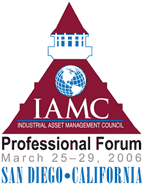 |
||||
|
January 2006
Relocation of Priorities (cover) Real Matter Lost in the Chatter Last Call for Alcohol Healthcare Projects Inoculate Local Economies… Nuts to You: Sara Lee Sells European Unit to PepsiCo Mobile on the Move Request Information 
|
Relocation of Priorities
All IAMC members are familiar with the basic ins and outs of the corporate relocation business. Transport routes are a serious part of the criteria for any company, and their constancy is indicated by their usual status as “infrastructure.” You can imagine, then, the obstacles facing departments of transportation and companies like my own employer, CSX, as we dig out from Gulf Coast 2005. In both Hurricanes Ivan and Katrina in successive years, CSX was hammered by major destruction to mainline railroad. Most recently, four miles of bridge across a bay were torn down to the pilings. The concrete bridge cap and road structure above was scattered across a large area. Bridge building is a slow process. And yet the design and construction team finds a way to beat the aggressive schedule set at the outset. This time, while work on reconstruction of the rail is nearly complete, one of the ideas re-emerging is the movement of CSX track to the north of Gulfport and Biloxi, allowing the state and federal authorities, should they wish, to build a new road along our right-of-way. The new line would open up land for industry and employment. Such a move would, for one thing, remove dozens of at-grade crossings from the rail line, thereby improving the safety picture. New Orleans has a splendid opportunity as well to rebuild a much more beautiful and functional city and port. It must be done aggressively with strong design controls and utility. Urban design is an evasive area in a land ruled by property rights and local politics. Yes, I favor property rights, but I don’t favor windfall land profits from speculators who chase in front of the five-year road plan. Something has to change. The efficient use of infrastructure dollars depends on the alignment of land use planning and transportation corridors from the outset. Fundamental choices like these now face one of the most important shipping and energy regions in North America. Those making those choices would do well to bear in mind the exhortation of Mississippi Gov. Haley Barbour to make things better than they were before: “If it is simply a newer version of today, we will have failed,” he said. His point resonates in more ways than one: Not only is this a tremendous opportunity to really redesign external infrastructure, it’s an awakening to corporate real estate people to pay attention to disaster recovery and the frailty of our networks and systems. The balancing of these priorities is why IAMC members seek to understand these interdependencies, devise state-of-the-art solutions and bring best practices back home. And it’s why one of the prominent session themes at our upcoming IAMC Professional Forum in San Diego, March 26-29, will be disaster recovery and crisis management. We’ll sort through those tools which are economically beneficial for corporations to use versus those which are nice to have but don’t meet the ROI hurdle despite the high cost but low probability nature of natural disasters. The time for such focus can’t come too soon: Climate forecasters say we are in a cycle that will bring more large storms our way over the next few years. We will build it all back better and stronger. But we’ll be holding onto our hats while doing so.
|
|||
©2006 Conway Data, Inc. All rights reserved. SiteNet data is from many sources and not warranted to be accurate or current.
|


